|
| |
H - Q
| Half Hitch - A
single hitch made with one end round its own standing part. It is not
secure on its own and is usually the beginning of a more elaborate
hitch. |
 |
| Halter Hitch -
An excellent hitch for securing a rope to, say, a ring. It is untied
simply by taking the end out of the loose bight and pulling it. Ashley
states that this knot is used the world over for hitching horses. |
 |
Halyards - Definition.
Ropes for hoisting sails or yards.
| Handcuff Knot -
A double loop knot suitable for use for handcuffing a prisoner. One loop
is placed round each wrist, both ends pulled tight and then hitched
round the neck of the loop. Basically, it is identical to the Fireman's
Chair Knot when completed. |
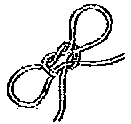 |
Handy Billy - Definition.
A small tackle kept handy for small jobs, consisting of two blocks, one with two
sheaves (pulleys) and the other with one, ready reeved. The Harvester's Hitch,
when used as an emergency tackle, is sometimes incorrectly called a Handy Billy.
| Hangman's Knot
- This knot needs no definition. It is made with eight or nine turns and
not thirteen as is often superstitiously suggested. Apart from its
obvious function, it is a useful knot for the end of a lanyard. |
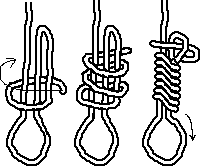 |
| Harness Bend -
A useful knot for small stuff in tying parcels, bales, etc. as it can be
pulled tight and tied while under tension. It will not capsize and is
very secure. |
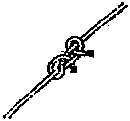 |
| Harvester's
Hitch - Sometimes also called the Haymaker's Hitch. Used by lorry
or truck drivers to secure a load. When a trapaulin is thrown over the
load and is being tied down, additional purchase is obtained by the use
of this knot and the rope drawn much tighter. The knot is also useful as
an emergency tackle when blocks with sheaves are not immediately
available. |
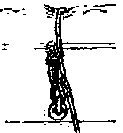 |
Hawser - Definition.
A plain laid rope, laid up righthanded, large enough (from 5 to 24 inches in
circumference) for towing and mooring.
Heaving Line Bend
- See Racking Bend.
| Heaving Line
Knot - Various arrangements are used to provide a weight at the
end of a rope which has to be thrown any distance. That shown here is
based on the Hangman's Knot and is widely used. The best of the several
knots for this purpose is probably the Monkey's Fist. |
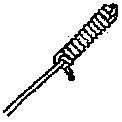 |
| Highwayman's
Hitch - A most useful Draw Hitch for securing a horse, a boat,
etc. or in self rescue work. The knot will take any amount of strain on
the standing part but spills the moment the end is pulled. Legend has it
that Dick Turpin used this knot on his nefarious errands: if in a hurry
to escape, he just had to leap on his horse, Black Bess, at the same
time snatching the end, when he was away. |
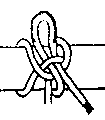 |
Hitch - Definition.
A knot which secures a rope to another object such as a post, spar or ring, etc,
or, in certain circumstances, another rope, e.g. a Rolling Hitch.
Hoist - Definition.
The perpendicular edge of a sail or flag which is next to the mast or flagstaff.
| Honda Knot - A
knot for making a lasso: it produces the most nearly circular of all
loop knots. It is made simply by putting a knotted end through an
Overhand Knot. It is sometimes called the Bowstring Knot but present day
archers prefer to use the Timber Hitch or else a bowstring with two
permanent loops. |
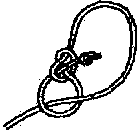 |
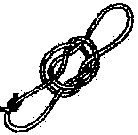 |
Jar Sling - A
knot for slinging or carrying a jug, bottle, har, etc., in fact
anythinhg which has some form of lip or restriction. The neck or mouth
is placed in the middle of the know and the ends pulled tight. This knot
is also of interest since there are at least half-a-dozen separate and
distinct ways of tying it. |
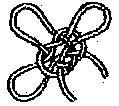 |
Jury Mast Knot
- Originally used to put a strap round a temporary mast head to which
stays could be made fast. Now more likely to be used for decorative
purposes or perhaps at camp to hoist a food supply, etc. off the ground. |
| Killick Hitch
or Kelleg Hitch - This is a Timber Hitch
with a Half Hitch added, usually round a large stone or chunk of rock.
Used by small ships on bottoms where an anchor might foul: also used for
anchoring lobster pots, small boats, etc. |
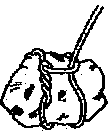 |
 |
Lark's Head - A
useful hitch, equally suitable for casks and bales, or keys, knives,
whistles or just labels and tags. Can be tied in the bight or with an
end. Also known as Cow Hitch, Ring Hitch or, if in a sling, Bale Sling
Hitch. |
Lanyard - Definition.
a) A small rope for securing the end of a stay. b) A 'handle' for almost
anything portable, movable, or losable, e.g. whistles, axes, knives,
marlingspikes, etc. Sailors found lanyard making an opportunity for displaying
their skill in decorative knotting.
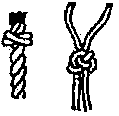 |
Lanyard Knot -
Various knots have been given this name but the Lanyard Knot proper is a
stopper knot in the end of a rope (rigging lanyards). The name is also
given to decorative knots on the other type of lanyard, particularly the
one shown here. |
Lashing - Definition.
a) Binding two or more objects together, usually spars, by means of turns of
rope. b) To secure a movable object by rope to prevent it shifting, as with deck
cargo, etc.
Line - Definition.
Common name for cordage, also used to make composite nouns such as lifeline,
clothesline, fishline, etc.
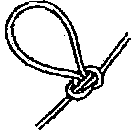 |
Linesman's Loop
- An excellent loop knot tied in the bight. It is superior to the Man
Harness Knot or Middleman's Knot. |
Long Splice - A splice
which has no apparent thickening of the rope at the points of joining. Used
where a rope has to pass through a block, or for endless belts used in lifts and
mining applications, etc. Unfortunately, it is impractical to illustrate.
| Magnus Hitch -
There is much confusion between the Magnus Hitch and the Rolling Hitch
and some authorities consider them to be the same knot. It is sometimes
accepted that the Magnus Hitch is the form used on spars while the
Rolling Hitch is the form used for hitching one rope to another -
generally a smaller one to a larger. In both forms the strain can be
taken at an acute angle. Compare illustrations. |
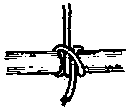 |
| Man Harness Knot
- Also called the Artillery Knot. A loop knot tied in the bight through
which an arm can be put up to the shoulder to assist in hauling, while
leaving the hands free. Formerly used on gun carriages, one end of the
rope being fastenend to a ring on the end of the axle. |
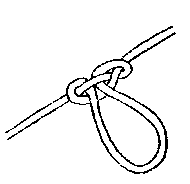 |
| Man Rope Knot
- A multi-strand knot in the end of a rope consisting of a Double Wall
and Double Crown. Tied in the end of manropes and sideropes to provide a
hand hold. It was properly made in four-strand rope and was often canvas
covered. |
 |
Marlinespike or Marlingspike
- Definition. A metal tool with a knobbed
head and tapering to a point. Used for tightening seizing, etc., and for opening
strands when splicing. The knobbed end is used for pounding.
| Marlingspike
Hitch - A temporay hitch made with a Marlingspike, or a tent peg,
etc., when extra strain is needed to heave a small rope taut, as, for
example, the turns of lashings or seizings. Also used on occasion in
Sheepshanks or Harvester's Hitch. |
 |
| Matthew Walker and
Double Matthew Walker - Probably the best
and most useful of the multi-strand rope end knots. It is claimed that
the unknown Matthew Walker is the only man to have a knot named after
him. |
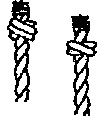 |
| Middleman's Knot
- Also called the Englishman's Loop (in America) the Fisherman's or
Angler's Loop, and it is one of the several knots known as True Lover's
Knot. It is a useful loop knot tied in the bight by one of at least four
different methods. Once much used for the middleman on a rope in
climbing, but now superseded for this purpose by better knots such as
the Alpine Butterfly. |
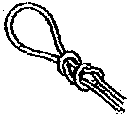 |
| Midshipman's
Hitch - An excellent hitch that can be temporarily or permanently
made. When used to make a loop, it can be slid to adjust the loop for
size. A good knot to know if you have fallen in the sea and a rope is
tossed to you. Also useful as a Guyline Hitch or to substitute for a
broken slider on a guyline. It is identical in form to the Rolling
Hitch. |
 |
| Monkey's Fist -
A knob knot at the end of a rope, usually made round a pebble or ball of
lead, etc. It is the best heaving line knot, the heavy core in the knot
giving it the weight to carry the mass of the line when thrown. |
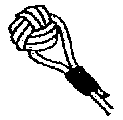 |
| Mousing A Hook
- If an appreciable load is to be on a block the hook should be 'moused'.
This strengthens the hook and at the same time prevents the rope from
jumping out. A 'mouse' is also raised on a particular rope to prevent
anything slipping off: in this case the diameter of the rope at the
particular place is increased by building up with turns and riding
turns. |
 |
Noose - Definition.
A loop which is made with the end round its own standing part in such a way that
it draws tight when hauled upon. Often erroneously callled a slip knot.
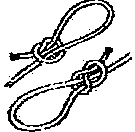 |
Noose, Simple
- The Simple Noose or Noose Knot is simply an Overhand Knot but with the
final tuck made with a bight instead of an end.. A Noose made with a
base of the Figure-of-Eight Knot is to be preferred. See also the
Running Bowline. |
| Overhand Bend
- Also called the Thumb Knot. Expedient as a bend, secure but weakening
to the rope. It is the knot tied by a mechanical binder. |
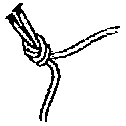 |
Overhand Knot - Also
called the Simple Knot, Common Knot, Thumb Knot, etc. It is the simplest knot
form, secure but weakening the rope considerably and should only be used in
small stuff. The Figure-of-Eight Knot is to be preferred.
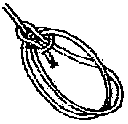 |
Portuguese
Bowline - There is some doubt as to which is the Portuguese and
which is the French Bowline, or whether they are they same knot. Ashley
gives the one shown here. It is an excellent double knot for rescue work
or as a Boatswain's Chair, made in the end of the rope. |
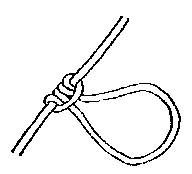 |
Prusik Knot - A
knot used by climbers. It is made with a strop (endless loop, either
spliced or tied) round the main climbing rope and the loop clipped into
a karabiner on the climber's waist band. It can be loosened and slid
along the rope to vary its position. |
| Quipus - The Incas
in Peru built and goverend well a huge empire but never discovered the
art of reading and writing. They evolved, however, a decimal system of
numbers by which records of every conceivable nature were kept. This
decimal system was operated by means of knots on lengths of cord of
various colours which were known as Quipus. |
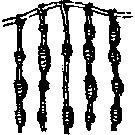 |
|
![[Company Logo Image]](_borders/unitheader.jpg)